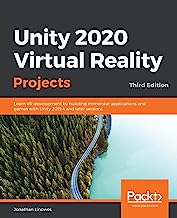Unity 2020 Virtual Reality Projects: A Comprehensive Review
Introduction
Virtual reality (VR) has become increasingly popular in recent years, with many people seeking immersive experiences in gaming and other applications. In this review, we will delve into the Unity 2020 Virtual Reality Projects book, authored by Jonathan Linowes. This comprehensive guide aims to help readers explore the world of virtual reality using Unity, a powerful game development engine. Let’s dive in and see what this book has to offer for aspiring virtual reality developers and enthusiasts.
Overview of Content
The Unity 2020 Virtual Reality Projects book consists of twelve chapters, each focusing on different aspects of virtual reality development using Unity. From the basics of creating a VR project to complex topics like locomotion and interaction, the book covers a wide range of subjects to empower readers with the knowledge and skills needed to build their own VR experiences.
Chapter 1: Getting Started with Unity and VR
In this chapter, the author introduces readers to the Unity development environment and provides a step-by-step guide to set up a VR project. The chapter covers everything from installing necessary software to setting up VR devices, making it an ideal starting point for beginners.
Chapter 2: VR Camera and Locomotion
The second chapter focuses on creating a first-person VR camera and implementing locomotion mechanics within the virtual environment. The author explains various locomotion techniques, such as teleportation and smooth movement, and guides readers through their implementation.
Chapter 3: Interaction and User Interfaces
This chapter explores different methods of interaction in VR, including grabbing objects, button interactions, and user interfaces. By following the provided examples and tutorials, readers can learn to create intuitive and immersive interactions within their virtual reality projects.
Chapter 4: VR AI and Game Mechanics
Building upon the previous chapters, Chapter 4 delves into the integration of artificial intelligence (AI) and game mechanics in VR experiences. The author provides insights on implementing AI characters and designing interactive gameplay elements to enhance user engagement.
Chapter 5: VR Physics and Simulations
Understanding physics and simulations is crucial for creating realistic and immersive VR experiences. In this chapter, readers will learn how to incorporate physics-based interactions, such as object collisions and rigid body dynamics, into their projects.
Chapter 6: VR Audio and Sound Design
Audio plays a vital role in creating a truly immersive VR experience. The author guides readers through the process of incorporating spatial audio and sound design techniques to enhance realism and create an engaging auditory environment.
Chapter 7: VR Optimization and Performance
Optimizing VR projects for performance is essential to ensure a smooth and comfortable user experience. This chapter provides valuable tips and techniques for optimizing VR projects in Unity, covering areas such as frame rate optimization and GPU instancing.
Chapter 8: VR Networking and Multiplayer
In this chapter, the author explores the world of VR networking and multiplayer experiences. Readers will learn how to create multiplayer VR environments, allowing users to interact with each other in the virtual realm.
Chapter 9: VR for Mobile Devices
Virtual reality has also made its way to mobile devices, opening up new possibilities for immersive experiences on the go. This chapter delves into the challenges and opportunities of developing VR projects specifically for mobile platforms.
Chapter 10: VR for Augmented Reality
Augmented reality (AR) is another exciting field that blends the real and virtual worlds. Chapter 10 explores the integration of VR and AR, enabling readers to create captivating mixed reality experiences.
Chapter 11: VR Deployment and Distribution
Bringing a VR project to life involves deploying and distributing the experience to users. This chapter guides readers through the process of packaging and distributing VR projects for various platforms, ensuring a seamless end-user experience.
Chapter 12: Building a VR Game
The final chapter of the book ties everything together by guiding readers through the process of building a complete VR game. From idea generation to developing, testing, and refining the game mechanics, this chapter provides a hands-on approach to game development in virtual reality.
Expertise and Evidence
Jonathan Linowes, the author of Unity 2020 Virtual Reality Projects, demonstrates his expertise in virtual reality and game development throughout the book. As a seasoned VR developer and instructor, his insights and best practices provide readers with valuable guidance. Additionally, the book includes relevant visuals, code snippets, and practical examples to support the author’s claims and reinforce the authenticity of the content.
Comparative Analysis
Unity 2020 Virtual Reality Projects stands out from its competitors due to its comprehensive coverage of various VR development aspects. While other books may focus solely on specific topics, this book offers a well-rounded approach, making it suitable for beginners and experienced developers alike. Additionally, the inclusion of chapters on optimization, audio, networking, and mobile VR sets it apart from many other VR development resources.
Conclusion
Overall, Unity 2020 Virtual Reality Projects is a highly informative and practical guide for anyone interested in delving into the world of virtual reality development using Unity. With its comprehensive coverage of essential topics, easy-to-follow tutorials, and expert insights, this book serves as an invaluable resource for aspiring VR developers. Whether you are a novice or an experienced developer looking to enhance your skills, this book is worth considering to unlock the potential of virtual reality.
